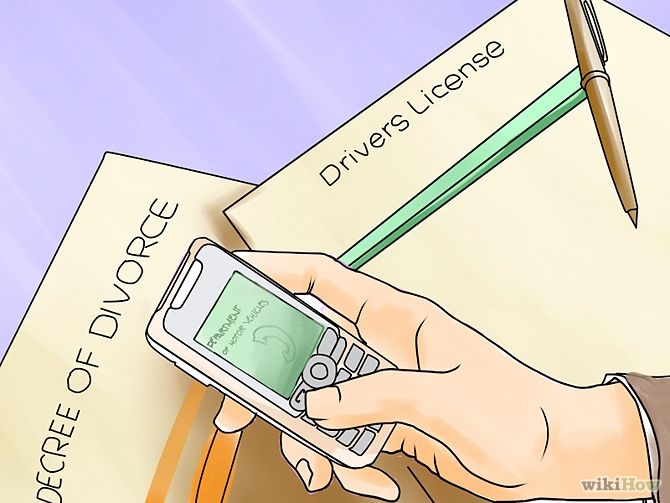Many women decide to change their name either during the divorce or within a short time afterwards. There are a number of reasons to take this action; as well as a number of problems which present themselves if you do decide to change it.
Even so, a fair number of women do end up changing their name after the marriage is over.
The procedures for making a name change vary from state to state and country to country. Therefore, we will take a very broad look at how it’s done in the United States and in the European Union. If the question of changing your name has left you slightly confused, then it is highly suggested that you whatever research possible on the internet to find the correct procedure for you for the city, state or area in which you live.
If you feel that there are enough other pressing issues, then leave the thought alone for the moment and come back to it later when you are feeling more clear-headed.
Why Change Your Name?
One of the questions a lawyer asks female clients during a divorce is, “Do you want a name change?” Many women are not sure how to answer that question. They just don’t know if they can, or should, continue using their ex-husband’s name.
Whereas, some women are more than happy to carry on using their ex-husband’s name without any emotional issues attached to it.
Change It
The idea of reclaiming their maiden name appeals to many women:
Emotionally they want to go back to where they were before the marriage or there may be be negative emotions associated with their married name.
Another reason to change your last name is to avoid the multiple hyphens that can occur after repeated marriages. A woman could literally find herself with a name like “Katherine Marie DeLyle-Hyde Park” after her third marriage! Names like these are “red flags” to prospective dates that this lady has been around the track quite a few times.
An interesting new trend is for women to pick an entirely new name. They see it as a fresh start in life.
“Many divorced women don’t want to be left with a last name that they did not grow up with. Many are reverting back to their maiden names, but more and more are choosing new last names,” said Kelly Utt-Grubb, a family naming expert (PR Web, 2008).
New last names can come from anywhere. Utt-Grubb said that, “Some pick a maternal grandmother’s last name or the name of another relative to whom they were very close. And some are even picking combinations of names. The new name is really a reflection of frame of mind and starting fresh.” (PR Web, Ibid).
There are a number of women who have not been content with just changing their last name. Some of them want a new first name, too, so they pick an entirely new name that represents how they see themselves.
The new trend in changing names is not isolated to just one country, or continent, or even to a newly-divorced woman. According to BBC News (2011), it is estimated that 58,000 people in the UK will change their name by the end of 2011.
This is an increase of 4,000 on the previous year. This increase has been confirmed by The UK Deed Poll Service. They have seen an increase of 30% compared with the same month last year.
Putting all emotional issues aside, there is one very practical reason for changing your name after your divorce. That reason is safety. Many victims of family violence are seeing a name change as a way to drop out of an abusive partner’s sight.
Some, if the circumstances are severe enough are even changing the last name of their children. The New Jersey Appellate Division led the way in a case entitled, The Application of E.F.G. to Assume a New Name. If you decide to take this route, then you need to make sure that your former spouse does not have your vital ID numbers such as your social security number (National Insurance number in the UK) or your driving license number.
One detective had great success in tracking criminals fleeing from arrest warrants. All he had to do was run their social security numbers through state employment reporting databases. People could change their names and locations, but the social security number always pinned down their location.
Today’s use of the internet makes it even easier if you have the right identifiers.
Leave It Alone
Another school of thought says it is easier to leave your last name as-is rather than change it. The process of legally changing your name is not a complicated one. The process of changing all your other documents once you have changed your name can be extremely daunting indeed.
Open your wallet or purse right now and take a look at all the documents you carry with you every day. Odds are that you regularly carry the following:
- A state ID or driver’s license
- An employee ID card
- Credit cards
- Debit cards
- Auto insurance card
- Your social security card
That is a total of at least six pieces of information that will need updating if you change your name.
Now, take a look at your home and financial records. All of the following will need to be updated according to your name change:
- All your bills
- The deed to your home
- The title to your automobile
And let’s not forget things like:
- The homeowner’s insurance policy
- Local tax bills
- Your bank accounts (both checking and savings)
- You may even have to your final decree rewritten and signed by the judge
A name change could complicate things like:
- Child support
- Health insurance
- Life insurance
- Custody arrangements
- Your passport and any other travel documents
Finally, you will still need to use your old name somewhere on employment applications. There is always a line on the application which asks for “Other names used” Failure to complete this section accurately can be grounds for the termination of your wonderful new job.
Another reason given by women not to change their name is that they have children. Children will generally carry their father’s family name – this is their birthright. But, confusion can result from children not having the same family name as their mother.
A good example of this is when the mother tries to pick up her child at school. Public and private schools have become very cautious about releasing children to adults during school hours.
Way too many family abductions have occurred during recent years at school. School secretaries almost never question an ID with the same family name as the children which means, in essence, that if the children carry the same name as their father and their father has a history of being violent with the children, then unless the school is informed, he may very well be allowed to collect your children from school – he has the same last name.
Things get a bit more complicated when the family name is different.There have been many instances of parents having to produce the final decree proving their custody of the children. Can you image the effect this has on everyone (mother and children) if the last name on the decree is different from the one on the ID?
Keep Your Maiden Name
The best advice we can offer is to keep your maiden name when you get married in the first place. Professional woman have long been keeping their original family names for business reasons.
There are some demonstrated benefits to keeping your original family name. WBZ TV News in Boston reported a European study on women who kept their maiden names. The study found that “women who keep their maiden names make $500,000 more than those who take their husband’s names” (Merrill, 2007).
A name is like a company brand. If the company suddenly changes its name, then it loses “brand identity.” Professional woman who changed their names after marriage lost name recognition, and in turn lost credibility, so it’s important to their business to keep things consistent.
In many cultures, such as the Orient, women traditionally keep their family names after marriage. There is no law in Europe or the Americas which states that you have to take your husband’s family name. Historically, however, only about 10% of women keep their original family name when they marry (Lowen, 2007).
That percentage now appears to be changing, and changing rapidly.If you do decide to retain your original family name, then you need to be consistent. Switching back and forth between names can be very confusing. If you are not careful, you could end up with different names on important documents. This will go beyond confusing and cause you real problems where identification is required.
However, if you do decide to change your name, for whatever reason, then the basics of both the American and European procedures are outlined on the following lines.
American Procedure
There are three ways you can change your name in the United States:
Going through the Divorce Process
A request for a name change is a common part of the original petition. Wives will include this if they file the suit for divorce.
Husbands filing the petition do not usually consider this issue. Husbands will often file the petition without including the request.
This is not a problem as the wife can include the request in her Answer to the Court. The lawyer tasked with writing the final decree includes an order for the change in the final document, assuming there has been no objection.
The nice thing about this route is that no additional hearing is required and there are no additional fees. The one drawback is that, in some jurisdictions, the wife can only ask for the return of her maiden name. Other jurisdictions will grant a complete change of name.
Making a Separate Request for a Change of Name
This is done via the Family Court. There are separate fees and a hearing before the judge will be required. It is worth pointing out that there are limits to how radical you can make your new name.
Names that are trademarked or celebrity names will generally not be approved. The same goes for single-word names, profanity or racially-degrading names. However, one man in Texas did get the judge to approve the name “Monster Jones.”
He’d been using it for years as a street name and it was already on his criminal history report! Monster Jones might have been lucky enough to get his name changed, but it wouldn’t be wise to try and be like Phoebe in Friends – she changed her name to Princess Consuela Banana-Hammock – odds are high that you would not get approval for something as drastic as this!
Many states publish fill-in-the-blank forms for name changes.Other states make form book examples readily available. We suggest you research the internet for specific information in your area.
Making a Name Change During Naturalization
There is a third, little known, way to change your name. Resident aliens who apply for citizenship can ask for a name change to occur once naturalization has been granted. This was done to allow resident aliens to Americanize their names.
The appropriate section on the application for citizenship is completed and the process is pretty much automatic and no additional fees are required.
European Procedures
Procedures for changing your name in Europe become much more complicated. This is because you are dealing with a variety of independent countries.
Many of these countries have legal systems which have a differing historical background. The United Kingdom bases their legal system on common-law. France bases its statutes on civil law. Each country can be slightly different.
This has resulted in a confusing mix of laws regarding changing your name. A name is considered fixed for life in Belgium.
Meanwhile in the United Kingdom both citizens and residents can change their names easily. The best that can be said is that you need to check within your own country what the rules are for changing your name. In the end, the best advice is to keep your original family name when you get married.
In conclusion, the question of whether to change a name after your divorce is increasingly being answered “Yes.” Women are not just reclaiming their maiden names. They are opting for complete changes that reflect their own personal preferences.
Just remember, as with most things, there are pros and cons to any decision you make. Making a legal name change is easy in the U.S. while it is much more complex in Europe. Once the change is made, there are additional documents you will need to change. It is a necessary part of the process that becomes a real challenge.
It really comes down to your own personal choice. There are no hard standards anymore on this issue.








